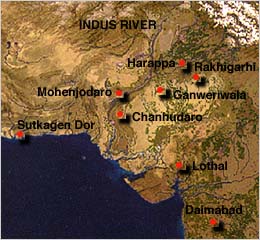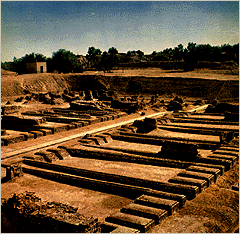The area of present Hoshiarpur District
was also part of
Indus Valley Civilization. Recent
excavations at various sites in the district have revealed that the entire
area near the Shiwalik foothills was selected for habitation not only by
the early palaeolithic man but also by those in the protohistoric and
historic periods. In the explorations, seven early Stone Age sited a
Atbarapur, Rehmanpur and Takhni, 30-40 km north of Hoshiarpur District in
the foothills of Shiwalik, have been discovered where the stone artifacts
have been found. Besides these excavations, among the archaeological
remains in the Hoshiarpur District, the remains of temples at Dholbaha, 24
km north of Hoshiarpur, and especially the local legends throw valauble
light on the ancient history of the district.
The legends associate several places in
the district with pandavas. Dasua is mentioned in epic of Mahabharata as
the seat of Raja Virata in whose services the Pandavas remained for
thirteen years during their exile. Bham, about 11 km west of Mahalpur is
said to be the place where the Pandavas passed their exile. Lasara, about
19 km north Jaijon, also contains a stone temple stated to date back to
the time of Pandavas. According to the chinese pilgrim, Hieun Tsang, the
area of Hoshiarpur was dominated by a tribe of Chandrabansi Rajputs, who
maintained an independent existence for centuries before the Muhammadan
conquest.
In the Hoshiarpur District, Shiwaliks
from Talwara on the Beas to Rupnagar on the Satluj have revealed the
presence of Acheolian and Soanian cultures. From the shiwalik frontal
range in the Hoshiarpur District, sixteen sites have been reported to have
yielded stone Age tools. Out of these, besides the Soanian tools, these
sited in Hoshiarpur District have yielded Acheolian assemblage.
The Atbarapur group has yielded a large
number of Stone Age tools. This group consisting of Atbarapur, Rehamanpur
and Takhni close to the dry beds of the Ghos are located at the foothills
of the Shiwaliks, about 8 km north-east from the town of Hariana,
Atbarapur has yielded 80 tools consisting of 9 handaxes, 19 cleavers, 17
pebble-tools, 28 flakes and 7 cores/core choppers. All the tools in the
collection are either on flakes or cores. The raw material is quartzite of
varying colours, viz. Green, blue, brown, etc. The tools are fashioned
mainly out of fine to medium grained quartzite. In the recent
archaeological excavations, some fine pieces of sculptures of Gandhara
dating back to 1000 AD and after have been discovered hare. A list of
stone tools yielding sited explored by the Department of Archaeological,
Punjab is given in Appendix-1 at the end of the chapter.
The archaeological explorations made
during the recent years have revealed the antiquity of the Hoshiarpur
District to the Harappan Period. On the basis of surface exploration, the
following new sited have been brought on the Archaeological map of India
and the traces of the selfsame people as at Harappa and Mohenjadaro have
also been detected in the Hoshiarpur District at the following places:-
|
S.No. |
Name Of Village |
Name Of Tehsil |
|
1 |
Daulatpur |
Hoshiarpur |
|
2 |
Rahamanpura |
Hoshiarpur |
|
3 |
Atbarapur |
Hoshiarpur |
|
4 |
Takhni |
Hoshiarpur |
|
5 |
Naroor |
Hoshiarpur |
|
6 |
Khangali |
Hoshiarpur |
|
7 |
Dholbaha |
Hoshiarpur |
|
8 |
Phappal |
Hoshiarpur |
|
9 |
Ram Tatwali |
Hoshiarpur |
|
10 |
Kot and its western Slopes |
Garhshankar |
|
11 |
Lalwan |
Garhshankar |
|
12 |
Manual |
Balachaur |
|
13 |
Gapalrian |
Dasua |
|
14 |
Mahatpur |
Dasua |
|
15 |
Kupowal |
Garhshankar |
|
16 |
Garhi |
Garhshankar |
|
17 |
Khanni |
Garhshankar |
|
18 |
Sham Churasi (Rural) |
Hoshiarpur |
|
19 |
Teheh (Pachrali) |
Garhshankar |
|
20 |
Ram Colony Camp |
Hoshiarpur |
|
21 |
Pakhowal |
Hoshiarpur |
|
22 |
Zahura |
Dasua |
|
23 |
Hajipur |
Garhshankar |
|
24 |
Jkam |
Dasua |
|
25 |
Tanda Urmur |
Dasua |
(B.B Lal, S.P. Gupta, Frontiers of the Indus
Civilization ( P 526) and Madhu Hala, Prachin Punjab Di Sanskriti ( Delhi,
1990)
The archaeological excavations carried
out at Dholbaha, situated at a distance of about 30 km to the north-west
of Hoshiarpur, reveal its relationship with the pre-historic period. This
area has been a place of habitation right form the very early times, the
archaeological discoveries have related its antiquities to the pleistocene
period. Fossils and stone tools found in this picturesque valley indicate
the appearance of early man here in this region. Presence of fossils and
beautiful sand stone sculptures of medieval period underline the
importance of Dholbaha and tend to establish the fact that Dholbaha valley
was occupied by the affluent iconolatry at various intervals. The
sculptures and other findings excavated from Dholbaha pertain to the
Gurjara Prathihara Period ( C-800-1100 A D). In the 10th
Century A D Shiwalik areas came under the influence of Pratiharas. During
that period, the art of the local tribes took a definite shape. In AD 965,
Jaipal came to the throne and thus the Hindu Shahi style penetrated into
the valley of Dholbaha. In AD 988, the rulers of Parmaras remained
paramount power upto AD 1260.
 The Indus Valley civilization
flourished around 2,500 B.C. in the western part of South Asia, in what today
is Pakistan and western India. It is often referred to as Harappan
Civilization after its first discovered city, Harappa.
The Indus Valley civilization
flourished around 2,500 B.C. in the western part of South Asia, in what today
is Pakistan and western India. It is often referred to as Harappan
Civilization after its first discovered city, Harappa. 